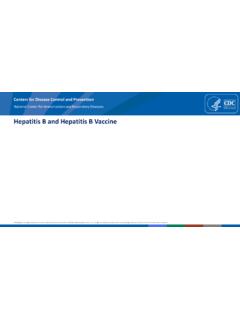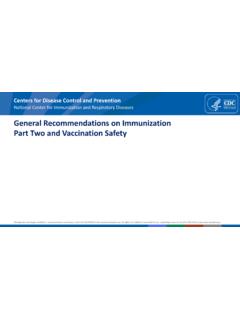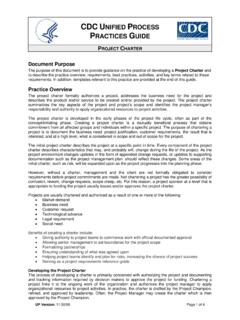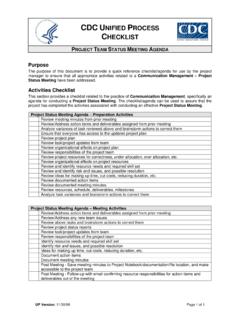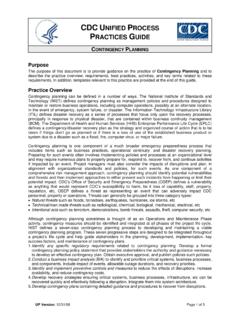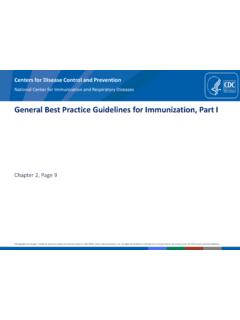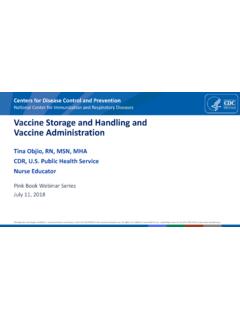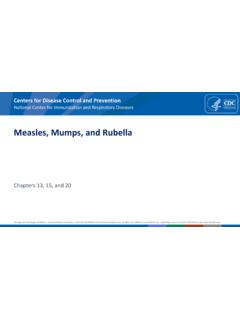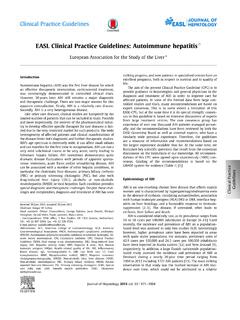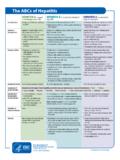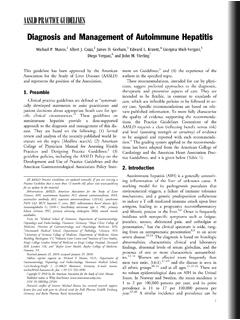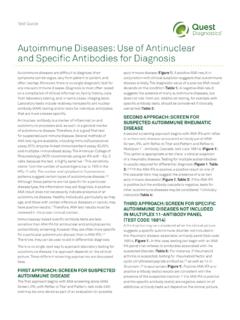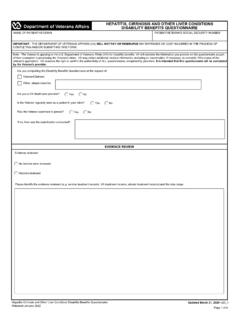Transcription of New Hepatitis A and Hepatitis B Vaccine Recommendations
1 National Center for HIV/AIDS, Viral Hepatitis , STD, and TB PreventionNew Hepatitis A and Hepatitis B Vaccine RecommendationsNoele Nelson, MD, PhD, MPHB ranch Chief (Acting), Division of Viral HepatitisCDC Lead, ACIP Hepatitis Vaccines Work GroupCurrent issues in Immunization WebinarSeptember 25, 2018 Hepatitis A VaccinesUpdate: Recommendations of the Advisory Committee on Immunization Practices for Use of Hepatitis A Vaccine For Post-exposure Prophylaxis and for International Travel Noele Nelson, Ruth Link-Gelles, Megan Hofmeister, Jos Romero, Kelly Moore, John Ward, Sarah Schillie Approved February 2018 ACIP meeting Publication anticipated: November 20183 Hepatitis A Vaccine for Post-Exposure Prophylaxis Recommendations for post-exposure prophylaxis (PEP) for Hepatitis A Hepatitis A (HepA) vaccines should be administered for post-exposure prophylaxis for all persons age 12 months In addition to Hepatitis A Vaccine , IG may be administered to persons age >40 years depending on the providers risk assessment Factors to consider in the decision to use IG in addition to Vaccine Age Immune status and underlying conditions Exposure type (risk of transmission) Availability of IG4 Hepatitis A Vaccine for Post-Exposure Prophylaxis, aged <12 months and persons for whom Vaccine is contraindicated Infants aged <12 months and persons for whom Vaccine is contraindicated (persons who have had a life-threatening allergic reaction after a dose of Hepatitis A Vaccine , or have a severe allergy to any part of this Vaccine ) should receive IG ( mL/kg)
2 Instead of Vaccine as soon as possible and within 2 weeks after exposure Note: The recommended interval for administration of MMR Vaccine is no earlier than 3 months after IG administration for Hepatitis A prophylaxis5 Approved; unpublishedHepatitis A Vaccine for Post-Exposure Prophylaxis, aged 12 months Persons aged 12 months who have been exposed to Hepatitis A virus (HAV) within the prior 14 days and have not previously completed the 2-dose HepAvaccine series should receive a single dose of HepAvaccine as soon as possible In addition to HepAvaccine, IG ( mL/kg) may be administered to persons aged >40 years depending on the providers risk assessment For long-term immunity, the HepAvaccine series should be completed with a second dose at least 6 months after the first dose; the second dose is not necessary for PEP6 Approved; unpublishedHepatitis A Vaccine for Post-Exposure Prophylaxis, aged 12 monthswho areimmunocompromised or have chronic liver disease Immunocompromised persons and persons with chronic liver disease who have been exposed to HAV within the prior 14 days and have not previously completed the 2-dose HepAvaccine series should receive both IG ( mL/kg) and HepAvaccine simultaneously in a different anatomical site as soon as possible after exposure For long-term immunity, the HepAvaccine series should be completed with a second dose at least 6 months after the first dose; the second dose is not necessary for PEP7 Approved.
3 UnpublishedHepatitis A Vaccines for International Travelers Recommendations for pre-exposure protection against Hepatitis A for travelers Hepatitis A Vaccine should be administered to infants age 6-11 months traveling outside the United States when protection against Hepatitis A is recommended The travel-related dose for infants age 6-11 months does notcount towards the routine 2-dose series Therefore, the 2-dose Hepatitis A Vaccine series should be initiated at age 12 months according to the routine, age-appropriate Vaccine schedule8 Hepatitis A Vaccines for International Travelers, IG cannot be administered simultaneously with MMR Vaccine , which is recommended for all infants aged 6 11 months traveling internationally from the , because antibody-containing products such as IG can inhibit the immune response to measles and rubella vaccines for 3 months Due to the greater severity of measles in infancy compared to HAV infection in infancy, MMR Vaccine should be administered preferentially to IG for HAV infection pre-exposure prophylaxis Administration of HepAvaccine (indication for off-label use) and MMR Vaccine to infants aged 6 11 months provides protection against both HAV and measles and allows for simultaneous prophylactic administration 9 Hepatitis A Vaccines for International Travelers, aged <6 months, and travelers who elect not to receive Vaccine or for whom Vaccine is contraindicated Infants aged <6 months, and travelers who elect not to receive Vaccine or for whom Vaccine is contraindicated should receive a single dose of IG ( mL/kg for travel up to 1 month; mL/kg for travel up to 2 months) prior to travel when protection against Hepatitis A is recommended If travel is 2 months or longer, a repeat dose of mL/kg every 2 months should be administered10 Approved.
4 UnpublishedHepatitis A Vaccines for International Travelers, aged 6-11 months Hepatitis A Vaccine should be administered to infants aged 6 11 months traveling outside the United States when protection against Hepatitis A is recommended This Vaccine dose does not count towards the 2-dose series. The 2-dose HepAvaccine series should then be initiated at age 12 months (at any interval after the dose administered for international travel pre-exposure prophylaxis) according to the routine, age-appropriate Vaccine schedule 11 Approved; unpublishedHepatitis A Vaccines for International Travelers, persons aged >12 months 40 years Healthy persons aged 12 months 40 years who are planning travel to an area with high or intermediate Hepatitis A endemicityand have not received HepAvaccine should receive a single dose of HepAvaccine as soon as travel is considered and complete the 2-does series according to the routine schedule12 Approved; unpublishedHepatitis A Vaccines for International Travelers, adults, immunocompromised persons, persons with chronic liver disease Persons with chronic liver disease as well as older adults (aged >40 years), immunocompromised persons, and persons with other chronic medical conditions planning to depart to a risk area in <2 weeks should receive the initial dose of Vaccine , and also simultaneously can be administered IG at a separate anatomic injection site ( mL/kg for travel up to 1 month at a separate anatomic injection site; mL/kg for travel up to 2 months; repeat dose of mL/kg every two months)13 Approved; unpublishedHepatitis B VaccinesNew ACIP Hepatitis B Recommendations , January 2018 Schillie S, Vellozzi C, Reingold A, Harris A, Haber P, Ward JW, Nelson NP.
5 Prevention of Hepatitis B Virus Infection in the United States: Recommendations of the Advisory Committee on Immunization Practices. MMWR Recomm Rep 2018;67(No. RR-1):1 31. DOI: ACIP Recommendations Single document with guidance for: Hepatitis B (HepB) vaccination of infants, children, adolescents, and adults Testing pregnant women for Hepatitis B surface antigen(HBsAg), and, if positive, Hepatitis B virus (HBV) DNA HepBpre-vaccination and postvaccinationserologic testing HBV post-exposure prophylaxis (occupational and non-occupational exposures)5 New ACIP Recommendations , cont. Incorporates previously-published Recommendations from: ACIP CDC Augmented with American Association for the Study of Liver Diseases (AASLD) recommendation 8A: The AASLD suggests antiviral therapy to reduce the risk of perinatal transmission of Hepatitis B in HBsAg-positive pregnant women with an HBV DNA level >200,000 IU/mL 6 Birth Dose All infants born to HBsAg-positive women should receive HepBvaccineand ( Hepatitis B immune globulin) HBIG within 12 hours of birth,administered at different injection sites Only single-antigen HepBvaccine should be used for the birth dose Recommend Hepatitis B Vaccine birth dose within 24 hours of birth formedically stable infants weighing 2,000 grams and born to HBsAg-negative mothers Aligns with the World Health Organization (WHO) recommendations18 Testing Pregnant Women for HBV DNA HBsAg-positive pregnant women should be tested for HBV DNA toguide the use of maternal antiviral therapy for preventing perinataltransmission (new recommendation) AASLD suggests maternal antiviral therapy when maternal HBVDNA is >200,000 IU/mL (new recommendation)
6 14 Testing Pregnant Women, cont. Commercial laboratories should be encouraged to capturepregnancy status for women tested for HBsAgto aid inidentification of HBV-infected pregnant women (newrecommendation)16 Transferred Infants For infants transferred to a different facility after birth ( , hospital with higher level of neonatal care), staff at the transferring and receiving facilities should communicate regarding the infant s HepBvaccination and HBIG receipt status to ensure prophylaxis is administered in a timely manner(new recommendation) 24 Mothers with Unknown Status Infants born to women for whom HBsAgtesting results during pregnancy are not available but other evidence suggestive of maternal HBV infection exists ( , presence of HBV DNA, HBeAg-positive, or mother known to be chronically infected with HBV) should be managed as if born to an HBsAg-positive mother(new recommendation) 25 Postvaccination Serologic Testing (PVST) Recommended for infants born to.
7 HBsAg-positive mothers Mothers whose HBsAg status remains unknown indefinitely ( ,infants safely surrendered shortly after birth) (new recommendation) Performed after completion of HepB Vaccine series (age 9-12 months)(new recommendation) and at least 1 month after last HepBvaccine dose(to avoid detecting HBsAgfrom Vaccine )35 Revaccination Single-dose revaccination (new recommendation) For infants born to HBsAg-positive mothers who haveanti-HBs <10 mIU/mL after 3-dose series Follow with PVSTone month following vaccination If still anti-HBs <10 mIU/mL then2 more doses + PVST Alternate strategy: 3-dose revaccination then PVST44 Summary of Revised ACIP Guidance for Perinatal HBV Transmission Universal HepBvaccination within 24 hours of birth for infants 2,000grams Removal of permissive language for delaying birth dose Testing HBsAg-positive pregnant women for HBV DNA to guide maternalantiviral therapy Postvaccinationserologic testing for infants whose maternal HBsAgstatusremains unknown indefinitely Single-dose revaccination for infants born to HBsAg-positive mothers notresponding to the initial Vaccine series48 HepBVaccine and HBIG Schedule for NewbornsMaternal HBsAg statusInfant birth weight: 2,000 grams <2,000 gramsPositiveHepBvaccine and HBIG within 12 hours of birthHepBvaccine and HBIG within 12 hours of birth; do not count birth dose as part of Vaccine seriesUnknownHepBvaccine within 12 hours of birth*HepBvaccine and HBIG within 12 hours of birth.
8 Do not count birth dose as part of Vaccine seriesNegativeHepBvaccine within 24 hours of birth(new recommendation)Delay first dose of HepBvaccine until age 1 month or hospital discharge*Maternal status should be determined as soon as possible and if HBsAg-positive, the infant should receiveHBIG as soon as possible but no later than age 7 days19 Adults Recommended for HepB Vaccination Persons at risk for infection through sexual exposure Sex partners of Hepatitis B surface antigen (HBsAg) positive persons Sexually active persons not in a long-term, mutually monogamous relationship Persons seeking evaluation or treatment for a sexually transmitted infection Men who have sex with men Persons with a history of current or recent injection drug use Persons at risk for infection by percutaneous or mucosal exposure to blood Household contacts of HBsAg-positive persons Residents and staff of facilities for developmentally disabled persons Health care and public safety personnel with reasonably anticipated risk for exposure to blood or blood-contaminated body fluids Hemodialysis patients and predialysis, peritoneal dialysis, and home dialysis patients Persons with diabetes mellitus aged <60 years and persons with diabetes mellitus aged 60 years at the discretion of the treating clinician International travelers to countries with high or intermediate levels of endemic HBV infection (HBsAgprevalence 2%)
9 Persons with Hepatitis C virus infection (new recommendation),persons with chronic liver disease (including, but not limited to, those with cirrhosis, fatty liver disease, alcoholic liver disease, autoimmune Hepatitis , and an alanine aminotransferase [ALT] or aspartate aminotransferase [AST] level greater than twice the upper limit of normal) Persons with HIV Incarcerated persons Other persons seeking protection from Hepatitis B virus infection (even without acknowledgment of a specific risk factor)54 Chronic Liver Disease Vaccination for persons with chronic liver disease (including, but notlimited to, those with Hepatitis C virus (HCV) infection, cirrhosis, fatty liverdisease, alcoholic liver disease, autoimmune Hepatitis , and liver functiontests >2 times the upper limit of normal) 3-dose HepBvaccine coverage among adults aged 19 years withchronic liver conditions (2014): (95% CI, )28 New Advisory Committee on Immunization Practices (ACIP) Hepatitis B Recommendations , 2018 Schillie S, Harris A, Link-Gelles R, Romero J, Ward J, Nelson N.
10 Recommendations of the Advisory Committee on Immunization Practices for Use of a Hepatitis B Vaccine with a Novel Adjuvant. MMWR Morb Mortal Wkly Rep. 2018 Apr 20;67(15):455-458 New Vaccine : HEPLISAV-B FDA licensed 11/9/17 5th inactivated HBV Vaccine licensed for use in US (others: Engerix-B , Recombivax HB , Pediarix , & Twinrix ) Indicated for active immunization against infection caused by all known su btypes of HBV in persons aged 18 years Series of 2 doses, separated by 1 month Likely improved adherence compared to 3 dose/6 month schedule Uses 1018 adjuvant, which binds Toll-like receptor 9 to stimulate directed immune response to Hepatitis B surface antigen (HBsAg) S, Harris A, Link-GellesR, Romero J, Ward J, Nelson N. Recommendations of the Advisory Committee on Immunization Practices for Use of a Hepatitis B Vaccine with a Novel Adjuvant. MMWR Morb Mortal Wkly Rep. 2018 Apr 20;67(15) of HEPLISAV-B Studies demonstrate high rates of seroprotection 90-100% of subjects receiving HEPLISAV-B vs.
